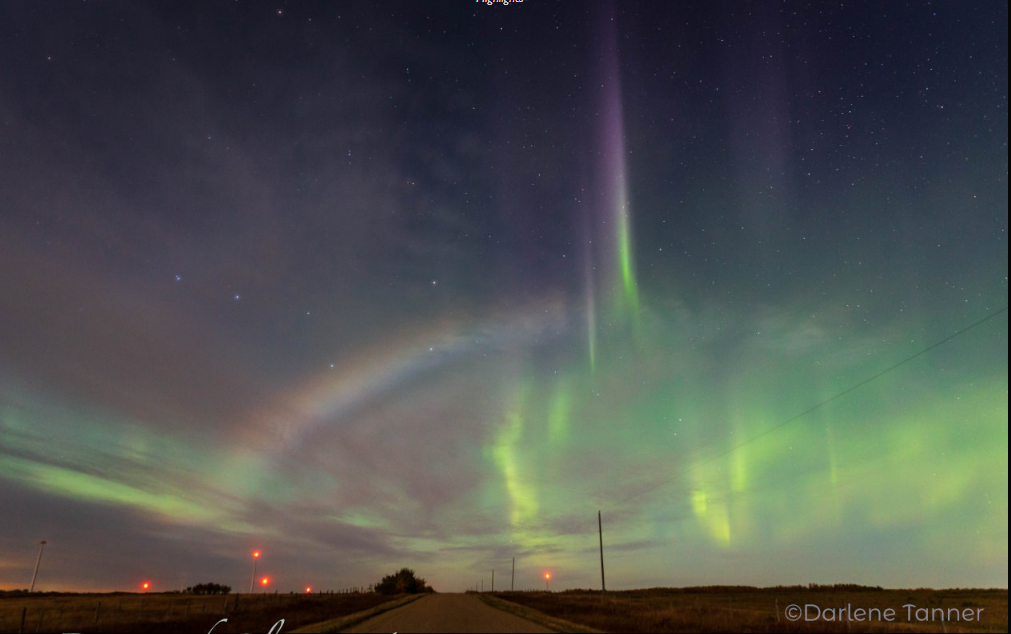Monnbow and aurora, Alberta Canada
Moonbow and Aurora: A Spectacular Display in Alberta, Canada
When it comes to atmospheric optics, few sights can rival the beauty and wonder of a moonbow and aurora appearing together in the night sky. In Central Alberta, Canada, photographers Darlene Tanner and Theresa Tanner were fortunate enough to witness and capture this breathtaking phenomenon. As avid aurora chasers, they were well-prepared to document the scene and share it with the world.
The moonbow they captured is a rare occurrence, intermediate between a traditional rainbow and a fogbow. Unlike rainbows that are formed by sunlight, moonbows are created when moonlight enters water droplets in the atmosphere and undergoes refraction and color splitting. The resulting bow is wider than a typical rainbow and exhibits pastel colors, with an almost white central band. Inside the moonbow, there are widely spaced supernumerary arcs, adding to its ethereal beauty.
What makes this moonbow even more remarkable is the presence of an aurora in the same frame. While the moon's photons scatter off the moon itself to create the bow, the particles responsible for the aurora have a more complex journey. These charged particles originate from the Sun and enter Earth's magnetosphere through its bow shock. However, their energy is initially too low to generate any visible aurora.
On Earth's dark side, these solar particles are stored in the magnetic bottle created by its long plasma sheath. When the magnetic field undergoes rearrangement, these particles are accelerated and spiral downwards along the magnetic field lines. As they collide with oxygen and nitrogen atoms in the upper atmosphere, these atoms become excited and emit colorful light, giving rise to the awe-inspiring display of the aurora.
The combination of a moonbow and aurora in a single photograph is truly a rare event. It showcases the intricate interplay between solar photons, Earth's magnetic field, and atmospheric particles. The presence of an 84% moon adds to the overall ambiance, casting a soft glow on the landscape and enhancing the visual impact of the scene.
It's worth noting that moonbows are particularly elusive due to several factors. The moon must be nearly full, and its light must be bright enough to create the necessary refraction in water droplets. Additionally, the moon's position in relation to the observer and the presence of rain or fog play crucial roles in determining whether a moonbow will appear. Therefore, capturing such a phenomenon requires not only skill but also a combination of favorable conditions.
For photographers like Darlene Tanner and Theresa Tanner, chasing auroras has become a passion. They dedicate their time and effort to seeking out these natural wonders and documenting their beauty. Their team, aptly named TeamTanner, ensures that they are always prepared to capture the elusive and mesmerizing displays of atmospheric optics.
In conclusion, the photograph of a moonbow and aurora together in Alberta, Canada, is a testament to the captivating beauty of our natural world. It serves as a reminder of the intricate processes occurring in our atmosphere and the extraordinary sights that can result from their convergence. Such phenomena are a reminder of the vastness and complexity of our universe, leaving us in awe of the wonders that surround us.

Bows and Glowing Atoms
Darlene Tanner caught this breathtaking scene of a hybrid lunar rainbow/fogbow and an aurora. Darlene together with Theresa Tanner chase aurorae and have a team .TeamTanner. Both witnessed and photographed the scene.
"I took this last night (28/29th Sept) in Central Alberta Canada. There was a G1 alert for Aurora and the clouds were rolling in fast. So I stayed in front of them until they overtook me at Castor Alberta. This was the scene right before they closed in. There was 84% moon behind me."
A mix of solar photons scattered from a fortuitously placed ball of rock a quarter of a million miles away and charged particles spilled from a magnetic bottle on Earth's dark side created the scene.
The Bow
Moonbows are rare. This lunar bow, intermediate between a rainbow and fogbow is rarer.
The bow is wide and pastel coloured with an almost white central band. Inside it is a widely spaced supernumerary. The water drops making it were small - small for rain and large for fog, somewhere in between.
Bows are created by sun or moonlight entering drops with refraction and colour splitting. The light reflects off the drop's opposite side and leaves with a second refraction and colour separation. Make the drop small and the light
waves interfere to blur the colours and broaden the bow into a fogbow.
The Aurora
The solar photons of the bow 'only' scattered off the moon. Particles making the aurora had a richer history.
Solar particles leaked through Earth's bow shock into its magnetosphere. Their energy was too low to light any aurora. They swept to Earth's dark side for storage in the magnetic bottle of its long plasma sheath.
Then the magnetic field rearranged. Particles accelerated hard and spiralled downwards along magnetic field lines. They thudded into oxygen and nitrogen atoms of the sparse upper atmosphere. The excited atoms lingered an eternity of atomic time then finally gave us the aurora's colours.
Note: this article has been automatically converted from the old site and may not appear as intended. You can find the original article here.
Reference Atmospheric Optics
If you use any of the definitions, information, or data presented on Atmospheric Optics, please copy the link or reference below to properly credit us as the reference source. Thank you!
-
<a href="https://atoptics.co.uk/blog/monnbow-and-aurora-alberta-canada/">Monnbow and aurora, Alberta Canada</a>
-
"Monnbow and aurora, Alberta Canada". Atmospheric Optics. Accessed on November 26, 2024. https://atoptics.co.uk/blog/monnbow-and-aurora-alberta-canada/.
-
"Monnbow and aurora, Alberta Canada". Atmospheric Optics, https://atoptics.co.uk/blog/monnbow-and-aurora-alberta-canada/. Accessed 26 November, 2024
-
Monnbow and aurora, Alberta Canada. Atmospheric Optics. Retrieved from https://atoptics.co.uk/blog/monnbow-and-aurora-alberta-canada/.